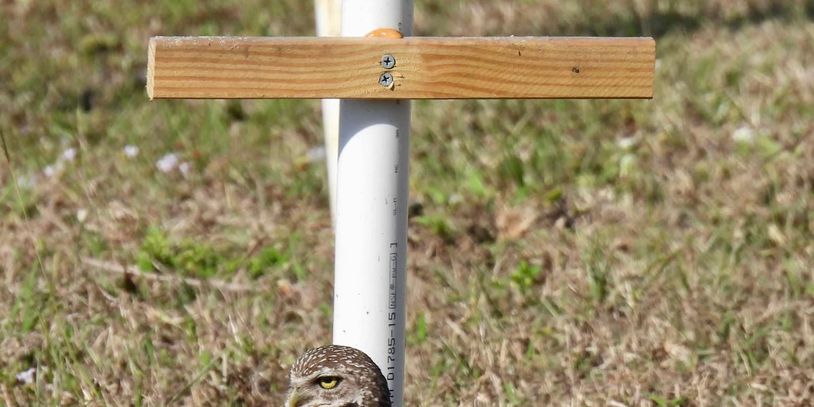Get Involved in Protecting Wildlife
Burrowing Owl Burrow Habitat Maintenance and Post Installation

Volunteers from Cape Coral Friends of Wildlife and Cape Coral Wildlife Trust receive special training before performing burrowing owl monitoring and maintenance tasks, adhering to FWC and City of Cape Coral regulations. Here are a few of the guidelines: Trim grass, weeds, and bushes no less than 5" in height within 10' of the burrow entrance, use a light-weight weed trimmer, stand on the sandy mound opposite the hole, not on the area behind the entrance, or you will collapse the tunnel,
Surrounding foraging habitat on-site should be kept low and open to provide burrowing owls with an unobstructed view of potential predators.
Vegetation or manmade structures must be placed at least ten feet from the burrow.
These plants and structures will prevent the owl from viewing his surroundings. He must be able to detect predators and find food.
Lot Signage
Posting can be an effective way to reduce encroachment within recommended buffers, to minimize disturbance, and to reduce the probability of burrow collapse. Cape Coral Wildlife Trust utilizes perches, FWC regulation signs and pvc piping to mark the location of burrows.
Posting and signage must be kept at least 10 ft. from the burrow entrance to avoid puncturing the tunnel.
Educational signage also can be posted. Care should be taken to place signage in a manner that maintains visibility for burrowing owls and is far enough away for people to read the sign without approaching too close to the burrow.
Interested groups can obtain burrowing owl signage by contacting the FWC’s Species Conservation Planning staff at the Southwest Regional Office, 863- 648-3200, or South Regional Office, 561-625-5122. Contacts for other regional offices are available on the FWC’s website.
Signs and postings require the property owner’s permission.
Cape Coral Wildlife Trust
PO Box 152624, Cape Coral, FL, 33915, USA
Contact: 2399802593 or [email protected]
Copyright © 2025 Cape Coral Wildlife Trust - All Rights Reserved.
Site Managed by FlashoverMediaGroup.com
The Owls Brought Snacks
Enjoy these cookies while you explore — they help us keep track of what works so we can save more habitat… no tiny beaks touched the batter, promise.